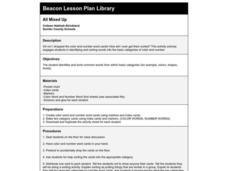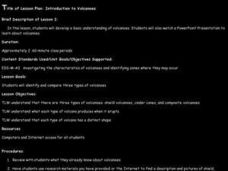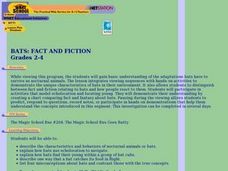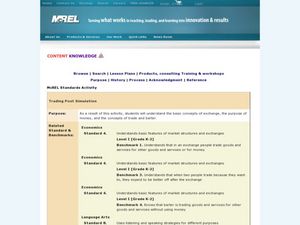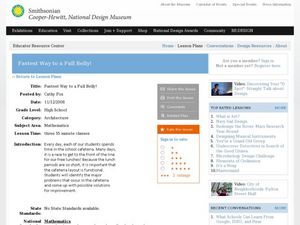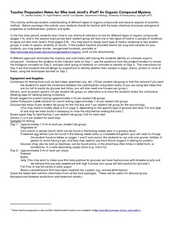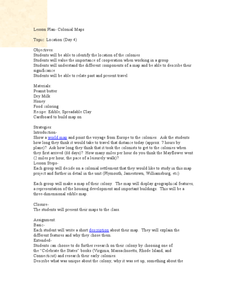Curated OER
57 Varieties of Interdependence
Students examine the life of Henry J. Heinz and how he began his career in food service. For this economic history lesson plan,students study how Henry J. Heinz started his business. Students will create and answer key questions that...
Curated OER
Everybody Needs
Students compare cultures. In this needs and wants lesson, students discuss the basic necessities of life and what they need in a day in order to survive. Students also discuss how these needs might change if they lived in another...
Curated OER
Exploring Limu Diversity
Young scholars explore limu diversity. In this ocean ecosystem lesson, students classify limu according to its physical properties. Young scholars work in small groups to generate scientific observations and sort limu by characteristics.
Curated OER
All Mixed Up
Students identify and sort words into the basic categories of color and number. After a lecture/demo, students utilize a worksheet imbedded in this plan to gain practice sorting number words.
Curated OER
Introduction to Volcanoes
Students develop a basic understanding of volcanoes. They watch a PowerPoint Presentation which introduces three types of volcanoes: shield volcanoes, cinder cones, and composite volcanoes.
Curated OER
The Life Cycle of the Butterfly
Second graders study the life cycle of a butterfly by observing metamorphosis taking place in a butterfly pavilion. Students illustrate their understandings of the body parts of a caterpillar and butterfly, as well as the life cycle,...
Curated OER
Treaties
Third graders explore Canadian history by participating in a role-playing activity. For this First Nation treaties lesson, 3rd graders identify the difficulties the Aboriginals faced when dealing with early European settlers. Students...
Curated OER
How Can We Keep Our Forests Intact and Have Our Chocolate Too?
Fourth graders explore various methods of growing and harvesting rainforest foods in order to sustain its biodiversity. They discuss the various uses for trees from several viewpoints. Students research chocolate demand and land use...
Curated OER
Bats: Fact and Fiction
Students describe the characteristics and behaviors of bats. After viewing a video, they explain how bats use echolocation to navigate and how they find their young within a group. They list four misconceptions about the animal and...
Curated OER
Trading Post Simulation
Students explore the concept of trade. In this trade instructional activity, students simulate a trade store. Students are divided into two groups. Half the class runs the store, half the class are customers. Students try to trade goods...
Curated OER
Viruses, Bacteria, Protists, and Fungi
In this viruses, bacteria, protists, and fungi activity, students will review the basic characteristics of each of these groups. Students will complete 7 fill in the blank questions about viruses, 6 true or false questions about...
Curated OER
The Business of Design
Students visit the Design for the Other 90% exhibition. For this design lesson, student learn how to design for the population of the world that is poor or impoverished. In addition, students read New York Times articles and watch videos...
Curated OER
Fastest Way to a Full Belly
Students create a scale model of a cafeteria. In this scale instructional activity, groups improve their actual school cafeteria layout by taking measurements of the structure and redesigning furniture and food serving lines. They create...
Curated OER
Natural Features as a Resource
Students research how people use land and water features to meet their basic needs. In this natural features lesson, students review land and water features. Students discuss how the land is used to meet needs using a landscape picture...
Curated OER
Who Took Jerell's iPod?
Students investigate various substances to determine the perpetrator of a crime. In this biology lesson, students test for the presence of organic compounds in various samples. They identify an unknown substance based on its physical and...
Curated OER
Colonial Maps
Students discover the history of America by identifying the traditional colonies. In this U.S. history lesson plan, students examine a world map and identify where the voyagers left from Europe to arrive at the United States. Students...
Curated OER
Where Do Your Veggies Grow?
First graders investigate the origins of vegetables. In this Science lesson, 1st graders identify where fruits and vegetables come from. Students describe how people utilize plants.
Curated OER
Eating for Your Future
Students brainstorm ways to live healthy. In this health science lesson, students recipes that are healthy and appealing. They compile all recipes and develop a class cookbook.
Curated OER
Milk and Dairy Test
Students explore how to select and prepare milk and milk products, identify standard serving size for milk and milk products, review terms associated with milk and milk products, and demonstrate knowledge of how to use and care for these...
Curated OER
Knowing your nutrients
Students comprehend the basics of the nutrition label. They comprehend the Recommended Daily Allowances. Students analyze the regulations that govern food labeling. They review the Food Pyramid.
Curated OER
Design-A-Meal
Third graders record what they eat for a week. In groups, they develop a menu for a fictitious restaurant. They create dinners which include all groups from the food pyramid. To end the lesson plan, they practice making healthy food...
Curated OER
Staying Healthy Year Round
Students are read a variety of books and observe the weather in the different seasons. In groups, they compare and contrast the type of activities people are doing. They also discuss how they adapt to the changes in seasons by the...
Curated OER
The Needs of Living Things
Learners watch video clips of animals and plants in their natural environment, to gather evidence that all living things have basic survival needs. Students draw pictures of real or imaginary pets eating, drinking, breathing, and taking...
Curated OER
Insect Safari
Third graders name and identify three body parts of an insect, identify the characteristics that insects have six legs and one pair of antennae and categorize insects as to whether they are helpful or harmful.





